World coins
D-Day commemorated by four world-renowned Mints
On 6th June 1944, the D-Day Landings turned the tide of the Second World War. Allied troops landed at five different beaches, famously codenamed: Utah, Omaha, Gold, Juno, and Sword.
At these beaches, the largest amphibious assault in history was launched and this attack paved the way for the liberation of German-occupied France and is largely considered the start of the victory on the Western Front.
Most UK collectors will be familiar with the United Kingdom 75th Anniversary of D-Day £2 coin issued in 2019 to commemorate the historic event. However, Allied Nations across the globe have been commemorating this important anniversary with unique coin issues from their very own Mints.
Today, we will be looking at the extraordinary coins issued by Australia, Canada and Belgium, in addition to the UK £2, that have been brought together in a strictly limited presentation pack.
United Kingdom £2
Over sixty-one thousand British Troops were deployed as part of the D-Day Operations, landing on the 6th June at Gold and Sword. What’s more, by 1944 over 2 million troops from over 12 countries were in Britain in preparation for the invasion.
To commemorate Britain’s great effort in opening up this second front against the German army, The Royal Mint issued a United Kingdom £2 coin for 2019.
This coin was produced in collaboration with Imperial War Museums and was designed by Stephen Taylor. Speaking about his work on the design, Taylor emphasises that he wanted to ‘build up the scale of the operation’ and that the ‘fonts are inspired by markings on US, Canadian and British landing craft, capturing the spirit of the international cooperation.’

Canada $2
Operating within the British command structure, Canadian troops provided the third largest force for Allied operations in Western Europe. Landing at Juno, between British troops at Gold and Sword, over 21,000 Canadian troops were involved in the D-Day Landings.
The Canadians played a crucial role in the action that effectively ended the Normandy campaign a few months later, cutting off German forces at the Falaise gap.
To commemorate such a huge achievement, The Royal Canadian Mint issued a $2 coin, following their proud tradition of honouring Canada’s rich military history with commemorative $2 coins.
The design, by Alan Daniel, features unique touches of selective colour to honour this most special anniversary.

Australia $1
On D-Day, over 2,000 Australian airmen took part in the battle of the skies above the invasion beaches, in addition to 500 Australian sailors serving in the escort fleets.
Notably, Australian officers held places in various British units throughout the campaign, gaining experience of British practises which they could then take home after the war.
Designed by Bronwyn King, the intricate design on this Australian $1 shows a flight of planes all heading in a single direction, with an Australian Kangaroo featured at the bottom.
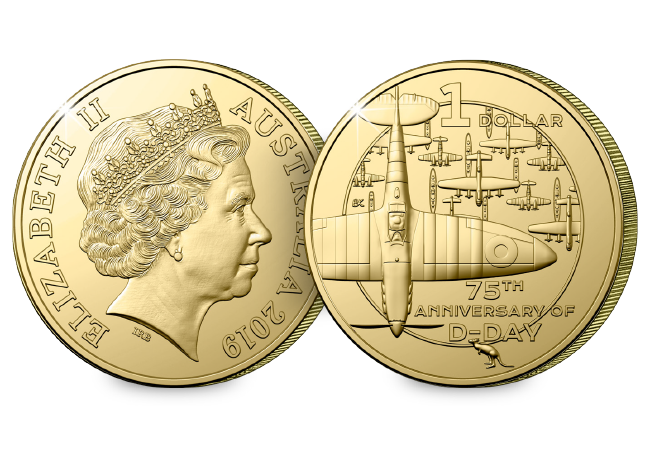
Belgium 5 Euro
Although there are few recorded Belgium troops on 6th June D-Day Landings, Belgium soldiers played a key part in the Battle of Normandy, which followed the initial D-Day Landings operation.
What many people also don’t know is that the exiled Belgium government in the UK raised its own units in Britain, and Belgium pilots flew in the RAF.
Designed by Luc Luycx, this remarkable 5 euro features a map of Normandy with arrows pointing across to the beaches where troops landed on D-Day. The reverse of the coin shows a map of Europe with ‘Belgium’ in the country’s three languages: French, Dutch and German.

A total of 156,000 Allied Troops took part in the D-Day Landings from across 12 countries – it truly was an international effort!
75th Anniversary of D-Day Allied Nations Coin Pack
To commemorate this most important anniversary year, Change Checker have brought together these four remarkable coins from four world-renowned Mints to create the Change Checker 75th Anniversary of D-Day Allied Nations Coin Pack.
The coins born from war and ice…
During its lifetime, The Royal Mint has struck coins for over 100 different countries from around the globe.
But do you know the story of how they came to strike Icelandic coinage?

The ‘inauguration’ of Iceland’s coinage
The story of how The Royal Mint came to strike Iceland’s coins began in World War Two.
After a night where the windows and roofs of The Royal Mint at Tower Hill had been destroyed by enemy action, the very first British-struck Icelandic coins were born as “a glacial wind whirled round the coining presses to inaugurate this coinage of Iceland” (explained by John Craig, The Deputy Master of The Royal Mint, in his annual report).
Prior to World War II, Iceland was ruled by the Danish crown and Icelandic coins had been struck by The Copenhagen Mint.
But the fall of Denmark into enemy hands during the war meant that Iceland had to look elsewhere for its coinage requirements…
First ever British-struck Icelandic coins
It was in 1940 that The Royal Mint received its first order to strike the five Icelandic denominations from 1 Eyrir (0.01 Krόnur) to 25 Aurar (0.25 Krόnur).
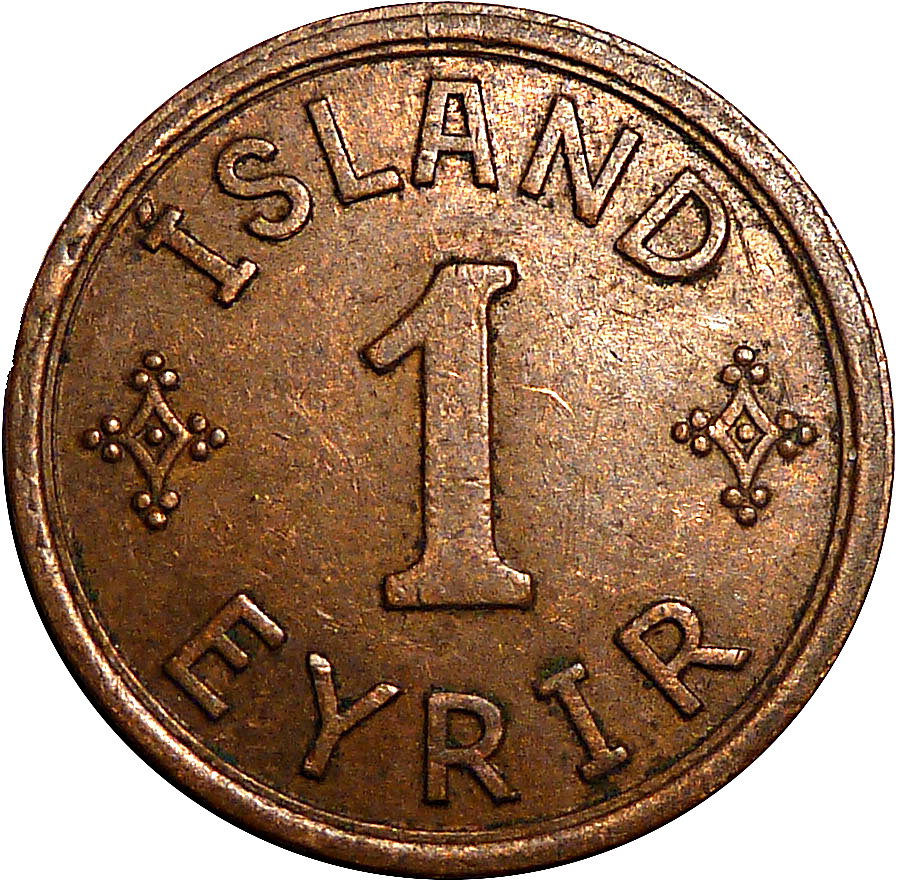
This was soon followed by additional orders for Krόnur and 2 Krόnur coins.
Not only did The Royal Mint experience damages to the building during WWII, but the price of nickel also rose substantially as the metal was in extremely high demand for munitions.
This meant it became necessary to strike the 1942 dated 10 and 25 Icelandic Aurar coins in the ‘poor metal’ of zinc rather than the now commonly used Cupro-nickel.
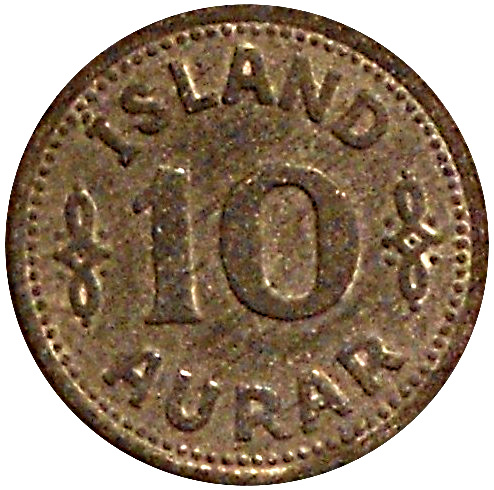
The new coins series
In June 1944 Iceland became a republic. A new series of coins were introduced in 1946, which remained in use for the next 35 years.
A full rendering of the national Coat of Arms appeared on the Krόnur and 2 Krόnur, complete with the bull, eagle, dragon and giant supporters.
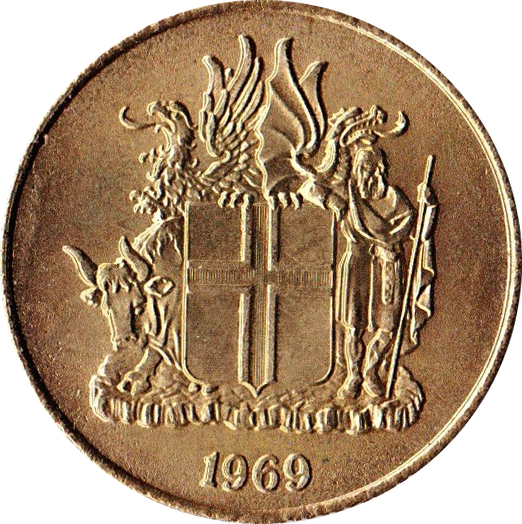
Four new denominations were added in the late 1960s, including the 50 Aurar, 5 Krόnur, 10 Krόnur and 50 Krόnur.
Iceland’s first commemorative coins
Iceland’s first commemorative coin was struck at The Royal Mint in 1961 – a gold 500 Krόnur marking the 150th anniversary of the birth of the scholar and statements, Jόn Sigurdsson.
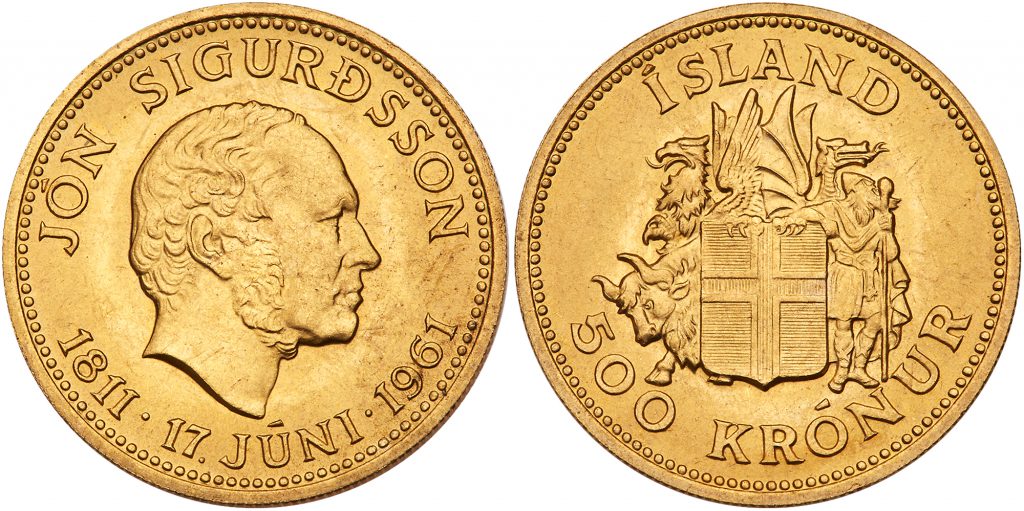
Iceland became a free and sovereign nation in 1918 when the Union Treaty with Denmark came into effect on the 1st December. To commemorate 50 years since this historic moment, a 50 Krόnur coin was issued.
In its first year of issue in 1968, the reverse design of the 50 Krόnur included a representation of the Althing (Parliament) building and carried an inscription marking the 50th anniversary of the achievement of Icelandic national sovereignty.
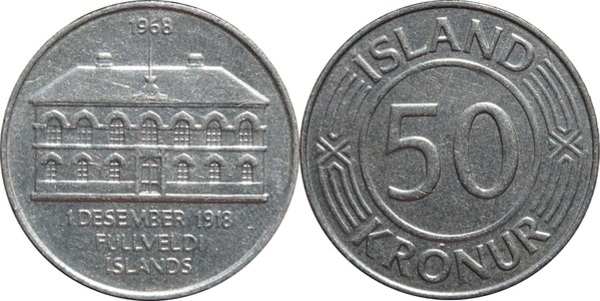
In 1974, The Royal Mint issued a three coin series of gold and silver coins, designed by Throstur Magnusson to commemorate the 1100th anniversary of the settlement of Iceland.
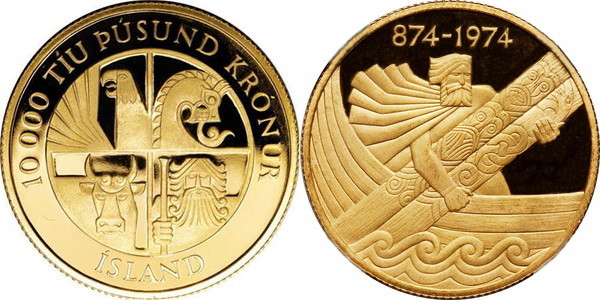
A major reform to Iceland’s coinage
The Icelandic financial market suffered hyperinflation in 1981, which was settled by a major reform of the coinage, resulting in a complete redesign and revaluation of the circulating coins.
100 old Krόnur was now worth just 1 new Krόna. As well as 1 and 5 Krόna coins, denominations of 5, 10 and 50 Aurar were also introduced.
The new obverses, in keeping with Magnusson’s designs, depicted the traditional protector spirits (“Landvættir”) of Iceland.

Each reverse portrays a variety of aquatic life, including dolphins, cod and northern shrimp.
As Iceland’s economy has been founded on fishing for so long, the pungent smell of fish smelting came to be known as “money smell”.
It’s great to discover more about different coins from around the world, and I’m sure you’ll agree that the stories behind Icelandic coinage are really fascinating.
If you’re lucky enough to have come across any Icelandic coins during your trips abroad, let us know in the comments below.
If you’re interested in coin collecting, our Change Checker web app is completely free to use and allows users to:
– Find and identify the coins in their pocket
– Collect and track the coins they have
– Swap their spare coins with other Change Checkers

Sign up today at: www.changechecker.org/app
It’s beginning to look a lot like Christmas! (oh yes it is!)
It’s beginning to look a lot like Christmas as Guernsey release a brand new set of Christmas Pantomime 50p coins!
These fantastic new coins feature designs based on five beloved Pantomimes which are sure to take you to a whole new world as you experience the magic of the theatre brought to life on a 50p coin.
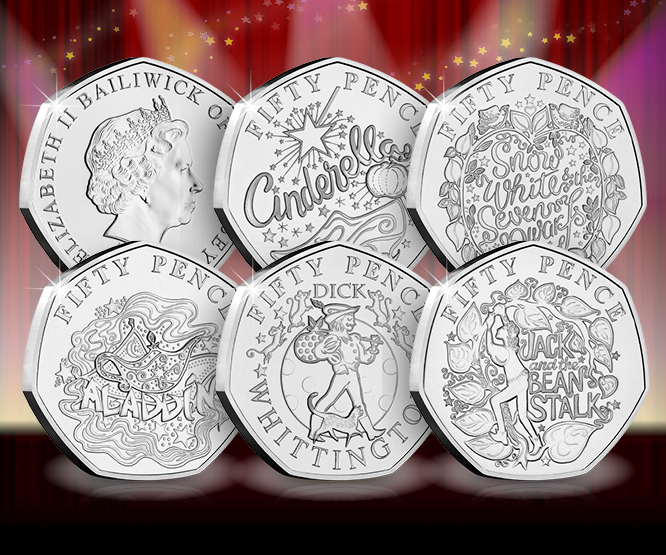
Complete BU Set
Whilst 4,000 of each design will be entering circulation, they will only be released in Guernsey and you can bet your bottom dollar that any lucky Guernsey Change Checkers coming across these coins will be sure to hold on to them.
Unfortunately we don’t all have a Fairy Godmother who can wave a magic wand and make these coins appear in our UK change (but wouldn’t that be nice!).
However, the complete set is now available to purchase in Brilliant Uncirculated quality here.
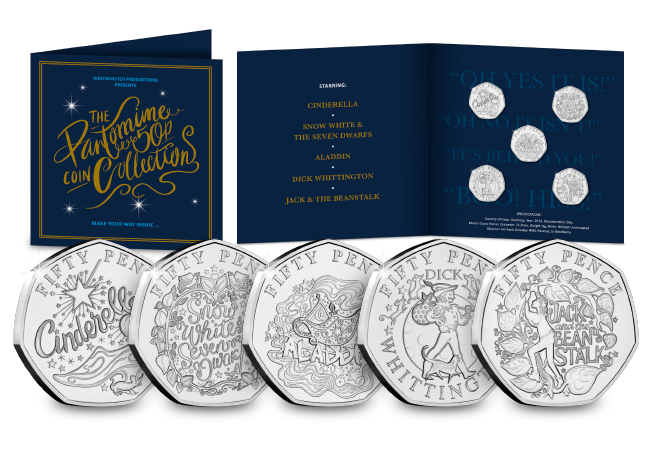
Authorised by the Guernsey Treasury and fully approved by Her Majesty the Queen, the set includes some of the most loved pantomime themes:
- Aladdin
- Cinderella
- Snow White
- Jack and the Beanstalk
- Dick Whittington
Silver Proof Set
But that’s not all… As if by magic, these coins have been brought to life in vibrant colour for the Silver Proof Pantomime 50p coin set.
Each beautiful coin is struck from Solid Silver and features selective colour printing to capture the fun of the theatre.
Only 2,019 of the Guernsey Silver Christmas Pantomime 50p sets are available and we all know how quickly Silver 50p coins sell out – the Silver Gruffalo 50p sold out within the first day of launch and had an edition limit of 25,000!
This stunning set is now available to purchase here.

The first Guernsey Christmas coins
Did you know that Guernsey has never released a Christmas coin before? This is bound to make these Christmas Panto 50ps particularly special for coin collectors.
However it’s fair to say that Christmas themed coins make an envious addition to anyone’s collection, with the numerous festive 50ps from the Isle of Man proving to be incredibly popular.
One of the most-loved Christmas themes to feature on a coin has got to be the Snowman.
In 2003, the first coin to feature the Snowman was issued by the Isle of Man and had a tiny mintage of just 10,000.
Although not many of these coins are available on the secondary market, if you did want to add one to your collection, you’d be looking at parting with a minimum of £200!

The Snowman has since featured on a number of Isle of Man Christmas coins, and even made his first appearance on a UK coin last year.
Just 20,000 issued for circulation
With such a wonderful Christmas theme and the fact that just 4,000 of each Panto 50p will initially be released into circulation in Guernsey, these coins are sure to follow in the Snowman’s footprints and be incredibly sought-after.
But it’s not just the theme which makes these coins so special…
Mintage figures for Isle of Man 50ps have never exceeded 30,000, and as the new Guernsey coins have a combined mintage of just 20,000 I’m sure you’ll agree that they are bound to be hugely collectable!
Guernsey mintage figures are known for being much smaller than the UK, which is down to their much smaller population of just over 63,000.
Vote for your favourite!
Pantomime has a long theatrical history and is especially popular during the festive period. So now it’s time to get the show started and celebrate with the fantastic new Christmas Pantomime 50p set from Guernsey.
We’d love to hear which of these coins is your favourite, so let us know by voting in the poll below!
Secure your Brilliant Uncirculated Christmas Pantomime Set
Celebrate the Christmas season with five brand new Brilliant Uncirculated Pantomime 50ps from Guernsey.






